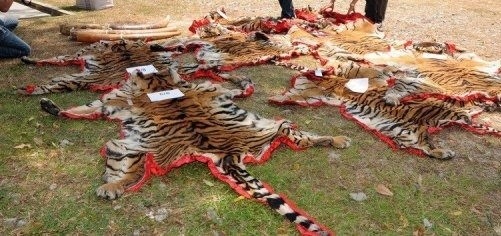Dehra Dun : The state forest department staff, right from the time when the region was part of Uttar Pradesh till today when it is part of Uttarakhand, the state government planners from years back to now who slowly but surely got rid of the corridors used by the wildlife for movement, the greed of the villagers living in the immediate vicinity of the Corbett and Rajaji National Parks, to set up resorts or sell their land for setting up resorts and the Van Gujjars living in the Park premises can be said to be the reasons that are taking a toll of the tiger.
There is no denying the fact that the felines are being killed on a big scale in the forests of Uttarakhand. Initially is was feared that it was the handiwork of poachers, who were selling the skins and organs to smugglers, but now it is clear that there is a poacher-villager-van gujjar-forest department nexus, that is responsible for the tigers being killed in large numbers in this small mountain state.
The forest staff first. It is well known that the patrolling in the forests is not to the extent to which it should be, because of which the short-comings are not pointed to the higher authorities for correction. The excuse is that the lower staff of the forest department who are to patrol the forests are not properly equipped and they are susceptible to attacks by poachers, which is true, but then it is for the department and the state government to do the needful.
The van gujjars have been depicted as lovers of wildlife by an NGO in particular that has been working with them and has got recognition for it. But sadly it has been quiet when recently the forest department arrested two members of the community for poisoning a tiger.
Now it is more than established that the van gujjars living in the forests are the ones who inform the poachers of the movement of tigers and help them kill the felines, besides poisoning them on their own.
The van gujjars were initially nomadic in nature who moved from the forest divisions in the lower areas to those in the higher reaches with change in climate. This not only helped the regeneration of the forests where they lived for only six months in a year with their cattle, but they could not establish contacts with poachers, as they moved away and their knowledge of animal movement in the particular forest also became outdated.
However, now their migration patterns have stopped and they are more or less established in a particular forest area. Their cattle over graze these forests, and reduces fodder for the herbivore population, on which the felines feed. There are allegations that as the trees are overlopped, they die and the wood is used by the van gujjars for their fuel needs, which turns large tracts of forest land barren.
Besides as they have stopped migrating, their cattle strength has increased manifold and they are virtually running dairs farms inside the forests at the cost of the forest.
Ironically, the forest department staff looks the other way to all these loopholes of the van gujjars. The reason for it is the fact that the van guijjars provide them with milk and milk produce as and when required. This quid pro quo relationship has continued for years and has given the van gujjars a solid footing in the Corbett and Rajai National Parks and their landscape. Despite efforts to remove them from these forests, they get protection from various quarters.
Then the forest department has not ever voiced its concern when planners have come up with development projects on forest land. Not only this they have also never ever raised their voice when private builders have put up huge resorts in the immediate vicinity of the Parks. Villagers living in the immediate vicinity of these parks have sold their land to the private resort builders for huge costs and then become infrastructure providers or guides to tourists who come and live at these resorts.
The net result is that the corridors used by the wild life for movement from one forest block to another has been closed and the felines who are territorial animals have been confined to small pockets not enough to sustain them.
There are reports that even the corridors used by them to go to the perennial rivers and streams in the summers for drinking water have gone and the tigers do not even get drinking water during the peak summer months,
With the herbivore population going down in the forests, whose areas are shrinking, the killing and eating habits of the felines has also changed. Rather than stalking the wild life, they find the cattle of the van gujjars, or that come from the village for grazing easier prey. Hence the attack on cattle have gone up over the recent years, which has only aggravated the man-animal conflict and the practice of poisoning the felines has taken root.
A journalist with over 40 years of experience, Jagdish Bhatt was Editor, Hill Post (Uttarakhand).
Jagdish had worked with India’s leading English dailies, which include Times of India, Indian Express, Pioneer and several other reputed publications. A highly acclaimed journalist, he was a recipient of many awards
Jagdish Bhatt, aged 72, breathed his last on 28th August 2021 at his Dehradun residence.




CTR management is highly disorganised & unprofessional.One is pained to see the ground realities & hear all sort of stories pertaining to this prime sanctuary – all for bad reasons !